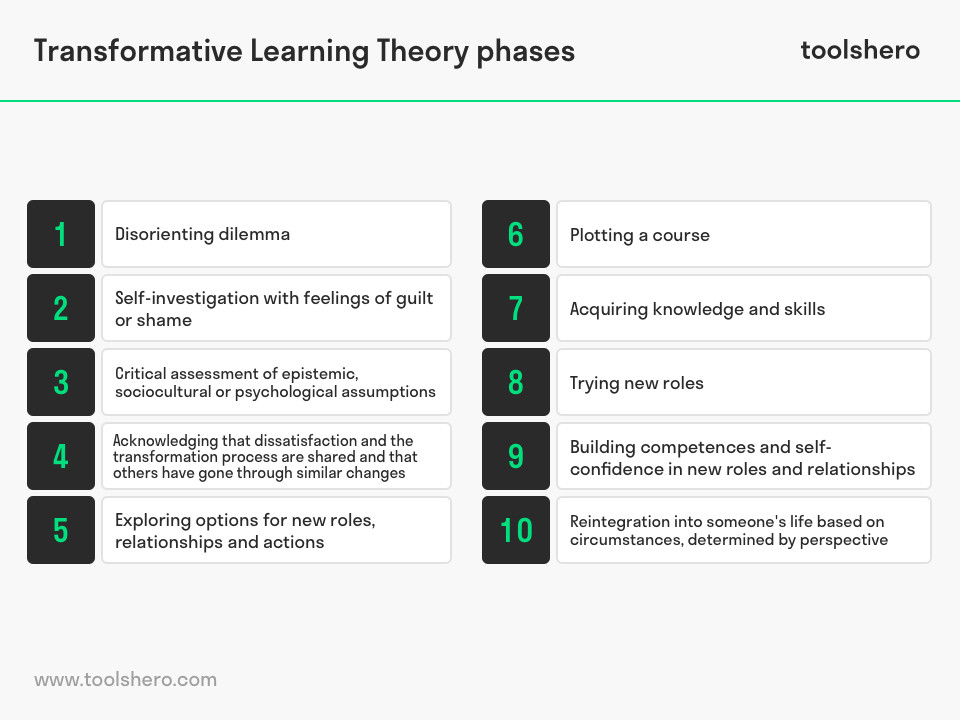Mezirow’s Transformative Learning Theory

Mezirow’s Transformative Learning Theory: this article provides a practical explanation of Mezirow’s Transformative Learning Theory. Next to what the theory is, the types of learning, the basic components of the theory, the role of parents and educators and to practice are been highlighted in this article. After reading, you’ll understand the basics of this theory. Enjoy reading!
What is Mezirow’s Transformative Learning Theory?
The Transformative Learning Theory is a theory developed by Jack Mezirow and concerns deep, useful and constructive learning. This way of learning transcends simply acquiring knowledge. It offers constructive and critical ways for students to consciously give meaning to their lives.
After application, this type of learning often changes into a fundamental change of their world view as a result of a shift in thoughtless or unconditional acceptance of available information into a conscious and reflective kind of learning that supports real change.
Jack Mezirow defines transformative learning as follows: transformative learning is the critical awareness of unconscious suppositions or expectations and the evaluation of their relevance for making an interpretation.
Definition
As the definition states, transformative learning often leads to a deep change the thoughts, feelings, perspective, convictions or behaviours of a person. This is caused by the fact that it facilitates a radical change of consciousness that permanently changes people’s world view. In students, it also leads to a paradigm shift that has direct impact on future experiences. An example of this is a student who suddenly discovers his or her hidden talent.
The theory describes two types of learning, instrumental and communicative learning. Instrumental learning is particularly aimed at learning through task-oriented problem solutions and determining cause-effect relationships. Communicative learning refers to how individuals communicate their needs, emotions and desires. This concerns the social aspect of learning.
Jack Mezirow developed the Transformative Learning Theory in 1978 when he worked at the University of Columbia. He came up with this theory after studying factors related to women’s success or lack thereof in the university programmes in the seventies.
He concluded that a perspective transformation is an important factor in this process. Since then, the theory has evolved into an expansive description of how students construe, validate and reformulate meaning to their experiences.
Types of learning according to Jack Mezirow
Jack Mezirow’s Transformative Learning Theory distinguishes between the following types of learning.
1. Communicative learning
Communicative learning aims to improve students’ communicative skills. Here, students learn how to communicate their wishes, needs and emotions.
2. Instrumental learning
Instrumental learning concerns task-oriented or problem-oriented learning. This could be in a classroom setting, but also online. Students are set the task of identifying cause-effect relationships of certain events or cases.
Three dimensions from the Transformative Learning Theory
According to Jack Mezirow, there are dimensions involved in perspective transformation.
1. Psychological
Students change their perspective or self-perception. Based on the Transformative Learning Theory, individuals must be able to think autonomously to truly learn. Instead of society or culture dictating what people should think and feel, they must develop their own meaning and interpretations.
2. Persuasive
Transformations in convictions such as personal values and assumptions. Instead of accepting the status quo, students change their cognitions based on their personal experience.
3. Behaviour
Students also change their lifestyle. For instance, they may change certain habits based on information they have received. This learning experience transforms their behaviour and impacts their actions.
Basic components from Jack Mezirow’s Transformative Learning Theory
There are two essential components of the Transformative Learning Theory that must be present to facilitate learning and transformation. These are:
1. Meaning structures
According to Jack Mezirow, students assign their own meaning to information, based on their personal cognitions. For instance, two people can interpret the same information in a completely different way. Mezirow suggests that there are three codes that form meaning structures:
- Sociolinguistic codes: the effect a society has on people’s schemas and structures. Common examples are social norms, cultural expectations and how language is used.
- Psychological codes: this concerns the emotional and mental state of a person. These include their thoughts and emotions that directly affect their meaning structures.
- Epistemic codes: epistemic codes are aimed at how knowledge is acquired, the validity of these and the conditions surrounding the learning experience. If new knowledge does not directly come from a reliable source, students will attach less value to it.
2. Critical reflection
Jack Mezirow also posits that individuals must think critically about their own experiences. This in turn leads to a perspective transformation. Students can only develop meaning structures if they are given the opportunity to reflect on their own learning behaviour.
This process of reflection increases their self-awareness and facilitates self-understanding on a deeper level. As a result, they are better able to manage and understand information and gain more from the experience.
On the other hand, reflection encompasses critical analysis of assumptions to determine whether a certain conviction, often stemming from cultural assimilation in childhood, remains functional for adults.
Individuals must be able to challenge and doubt their current assumptions and critically and carefully investigate the validity of these assumptions. In some cases, they discover that these cognitions are rooted in social or cultural convictions rather than their own meaning structures.
Critical reflection empowers them to criticise and change assumptions and make a meaningful change.
The Transformative Learning Theory and the role of parents and educators
There is no guarantee for transformative learning. Teachers and other educators can only offer students the possibility for transformative learning. Teachers can facilitate this by helping students become aware of and critically analysing assumptions. These include assumptions that lead to interpretations, convictions, habits and points of view.
Teachers must train learners in recognising certain reference frameworks. In doing so, teachers encourage students to assess problems from various perspectives. The goal is to develop a community of students who are united in a shared experience in the attempt to give meaning to their life experience.
The role of the learner
Teachers and educators become facilitators when the students’ goal is learning and building knowledge about themselves, others and social norms. For these reasons, students play a very important role in the learning environment and learning process. Students must develop norms in class, including politeness, respect and responsibility to help each other. Students must also encourage diversity within the learning environment and strive for mutual collaboration.
Furthermore, students must be critical of their own assumptions to transform their unchallenged reference framework. Through communicative learning, students work on critical reflection of assumptions that underlie intentions, values, convictions and emotions.
Students are once again involved in objectively reframing their reference frameworks when they reflect critically on their own and others’ assumptions. On the other hand, subjective redefining takes place when they critically assess their own assumptions.
Mezirow’s Transformative Learning Theory to practice
These dilemmas also occur in the context of academic learning environments. This is due to the fact that teachers offer room for critical analysis of new ideas and developments. Teachers who wish to use transformative learning in their classrooms may consider the following implementation strategies to train their students.
Offer opportunities for critical thinking
Teachers can offer opportunities for critical thinking by presenting the students with content that introduces new ideas or opinions.
Subsequently, students must work with the new content through conversations with other students and critical reflection of their own assumptions and convictions.
Offering opportunities to act from new perspectives
Research shows that it is crucial that teachers offer students the opportunity to put their newly found convictions into action. There are indications that a successful transformation is impossible when students are unable to take active steps to acknowledge their new conviction.
Transformative Learning Theory: the transformations in ten phases
A condition for being human is to the ability to give meaning to experiences. For some, each explanation from an authority figure is sufficient, but in modern-day society, people must make their own interpretations more often rather than acting based on the goals, assessments, emotions and convictions of others. Facilitating the acquisition of such insights is the main goal in adult learning. Transformative learning develops and encourages autonomous thinking.
A transformation that leads to a new perspective, however, is far less common. Mezirow believes that such transformations often arise from dilemmas caused by a major crisis or a life transition. It could also result from multiple transformations during a certain period.
Jack Mezirow describes ten phases that frequently occurred in his research into women who successfully studied at public universities.

Figure 1 – Mezirow’s Transformative Learning Theory: 10 phases
1. Disorienting dilemma
This dilemma represents the first theme of the three main themes of Mezirow’s Transformative learning Theory. A person had an experience that didn’t match his existing meaning structures, which caused a disorienting dilemma. As long as experiences match existing meaning structures, people usually don’t employ transformative learning.
These dilemmas can occur simultaneously, but also incrementally. This means a gradual recognition during a disruption between existing meaning structures and the environment.
The next two phases are important aspects of the second main theme from this critical theory: critical reflection.
2. Self-investigation with feelings of guilt or shame
3. Critical assessment of epistemic, sociocultural or psychological assumptions.
A person experiences this discomfort and subsequently assesses the validity of it, for instance during a walk.
The next phases represent the third and final main theme from Jack Mezirow’s Transformative Learning Theory: rational discourse.
4. Acknowledging that dissatisfaction and the transformation process are shared and that others have gone through similar changes.
5. Exploring options for new roles, relationships and actions
6. Plotting a course / planning a course of action
7. Acquiring knowledge and skills
8. Trying new roles
9. Building competences and self-confidence in new roles and relationships
10. Reintegration into someone’s life based on circumstances, determined by perspective
The above phases relate to someone in a transformative learning process because people develop a plan for implementing an approach. Subsequently, they acquire knowledge and skills needed for this plan.
This knowledge is acquired both through education and constant discussions with groups about establishing the needs of other group members. Additionally, an individual will then try out different roles in different ways.
Now it’s your turn
What do you think? Do you recognise the explanation of the Transformative Learning Theory? Do you recognise the different phases of transformation? Are you critical of assumptions, convictions and world views? Have you experienced a clear transformation in your learning process? Is this theory used in your educational environment? Do you have any tips or additional comments?
Share your experience and knowledge in the comments box below.
More information
- Kitchenham, A. (2008). The evolution of John Mezirow’s transformative learning theory. Journal of transformative education, 6(2), 104-123.
- Mezirow, J. (1997). Transformative learning: Theory to practice. New directions for adult and continuing education, 1997(74), 5-12.
- Mezirow, J. (2018). Transformative learning theory. In Contemporary Theories of Learning (pp. 114-128). Routledge.
- Website Certlibrary. Retrieved 02/20/2024 from Certlibrary.
How to cite this article:
Janse, B. (2020). Mezirow’s Transformative Learning Theory. Retrieved [insert date] from Toolshero: https://www.toolshero.com/personal-development/transformative-learning-theory/
Original publication date: 09/09/2020 | Last update: 02/20/2024
Add a link to this page on your website:
<a href=”https://www.toolshero.com/personal-development/transformative-learning-theory/”>Toolshero: Mezirow’s Transformative Learning Theory</a>












